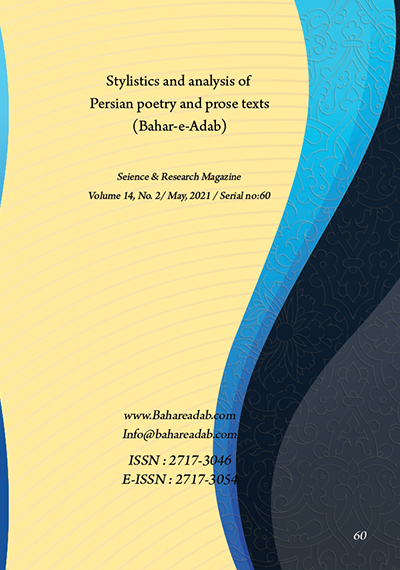- Count View : 486
- آدرس کوتاه شده مقاله: https://bahareadab.com/article_id/1085
- کد doi مقاله: Doi: 10.22034/bahareadab.2021 .14 .5403
Journal of the stylistic of Persian poem and prose
volume Number 14،
number In Volume 2،
،
issue Number 60
The Effect of Religious Teachings on the Depiction of the World in Rumi's Masnavi Ma'anavi
Mohammadhossein Sadeghidarvishi , Yadolah Maleki (Author in Charge), Jafar Taban
Abstract
BACKGROUND AND OBJECTIVES: In Islamic culture, like different human cultures, much has been said about the world and its examples. The great Persian poets have often dealt with this issue based on their religious attitude and intellectual nature. Rumi, as one of the greatest poet-mystics in Persian literature, has also expressed his views and position about the world instead of Masnavi. This study intends to search for its roots and bases among verses, hadiths and narrations by examining the rhetorical images of the world in Masnavi. In fact, the main question of the present study is which positive or negative images of the world in the spiritual Masnavi overlap with the views of the Holy Quran and other religious texts, and to what extent is the Masnavi influenced and inspired by these texts in presenting these images?
METHODOLOGY: The method of conducting the present research will be library type in terms of content analysis. Thus, in the beginning, by studying the Masnavi Manavi and other related sources, as well as by using various books, and referring to various electronic databases and using publications and magazines that are related to the research topic, the desired materials are filtered and then They are categorized comparatively according to the content of the content.
FINDINGS: Rumi has a Quranic and revelatory view in expressing most of the images of the world, and by mastering the divine book, while being influenced by verses and hadiths, he describes the world in a completely beautiful way.
CONCLUSION: The miracle and beauty of his work is that these descriptions and images have been created in a eloquent and allusive way. Also, the negative and reprehensible images of the world are presented in this work far more than the positive images (almost twice), however, in no case is life itself presented as low and worthless, but it may be presented as low for human beings.
Keyword
world
, Masnavi Ma'anavi
, Rumi
, Quran
, hadiths
, rhetorical image
, allegory
- The Holy Quran.
- Aref, Sayyid Muhammad Sadiq. (1998). Rah Roshan, Mashhad: Astan Quds Razavi, p 19.
- Dailami, Hassan Ibn Muhammad. (1992). Ershad al-Qulub. Volume1, qom: Al-Sharif Al-Razi, p182.
- Forouzanfar, Badi'alZaman. (2002). Masnavi's Hadiths and Tales, Translated and edited by Hossein Davoodi, Tehran: Amirkabir, p 282.
- Ghazali, Mohammad Ibn Mohammad. (2013). Ehya-ye Olum al-din, Translated by Moeinoddin Mohammad Kharazmi. Volume 15. Eighth Edition, Tehran: Scientific and Cultural, p 187.
- Ibn Abitaleb, Ali. (1999). Nahj al-Balaghah. Translated by Muhammad Dashti, qom: Nashar alHadi.
- Jafari, Mohammad Taghi. (1968). Interpretation, Critique and Analysis of Masnavi, Tehran: Islamic Publications, p 595.
- Jalalodin Abdolrahman. (1983). Duarar Al-Minthur fi Al-Tafsir bi Al-mathur, Volume One, qom: Aytpllah Marashi Al-Nujafi, p 244.
- Majlesi, Mohammad Baqir. (nd). Behar Al-Anvar. Volumes 65 &87, beyrut: Dar Al-Ahya Al-Tarath Al-Arabi, pp 159 & 279.
- Mawlavi, Jalal Al-Din Muhammad. (1988). Mathnawy Manavi. With the Correction of Reynold Nicholson, Tehran: Mowla.
- Mohaghegh, Seyed Mahdi. (2017). Thirty poems of Nasir Khusraw, Tehran: Toos, p 293.
- Motahari, Morteza. (2001). An Investigation of Nahj Al-Belagheh. Fourteenth Edition, Tehran: Sadra, p 276.
- Sa'adi, Mosleh Al-Din. (1980). Bustan. Edited by Gholam Hossein Yousefi, Tehran: Association of Persian Language and Literature Teachers.
- Sa'adi, Musleh Al-Din. (2014). Koliyat Sa'adi. Muhammad Ali Foroughi, Tehran: Hermes, p 948.
- Tabarasi, Fazl Ibn Hassan. (1980). Tafsir Majma Al-Bayan. Translated by Mohammad Razi. vol 27, Tehran: Farahani, p 384.
- Tabatabai, Mohammad Hussein. (2003). Tafsir Al-Mizan.
- Translated by Seyyed Mohammad Baqir Mousavi Hamedani. Volume 18, Tehran: Islamic Publications Office.
- Tamimi Amadi and Abu al-Fath Abd al-vahid. (1985).
- Gharr al-Hukm and Dorr al-Kalam, Tehran: Dar Al-Ketab Al-Eslami, p 364.
- Zarrinkub, Abdolhossein. (1997). Step by Step to the Meeting of God. Tenth edition, Tehran: Scientific, p 277.

